Car Navigator Lexand ST 5650 Pro HD
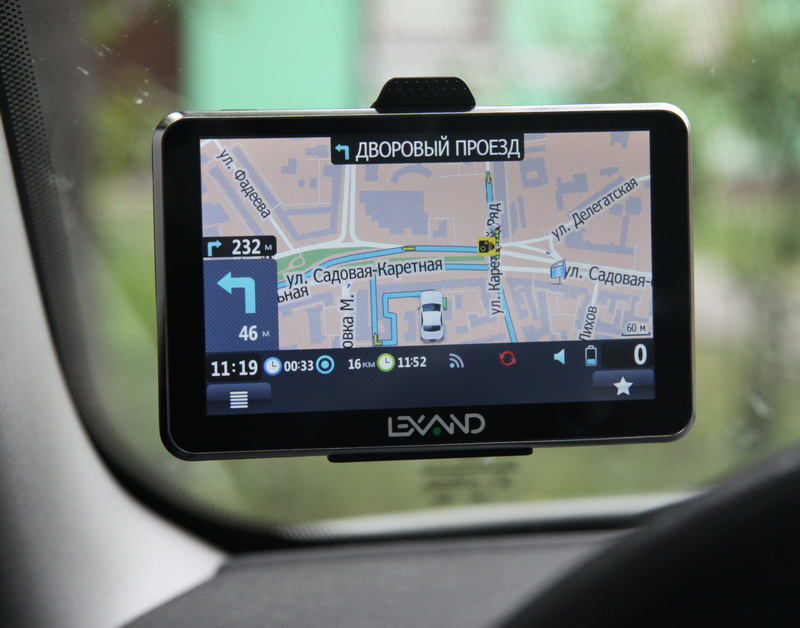
Persistently ignoring the progress, I always take with me on long journeys an outdated gadget - car navigator. Yes, almost all mobile devices have a GPS receiver. However, navigators for some reason continue to be sold and multiplied. What is the reason? Let's look at alternatives.
Smartphone . This is the main competitor to the traditional navigator because of its prevalence. Everything in it is good, except for the size of the screen. I traveled around the city for several weeks with a standard phone with a 4-inch screen. You get used to it, of course, but still, even with good resolution it is often difficult to disassemble small street names without being distracted from driving.
')
Tablet A huge 10-inch tablet on the dashboard looks pretty ridiculous. Yes, and fix it is not so easy. 7-inch tablet is just right as a navigator. Many who have it do just that. But for those who do not have a tablet, the question of price arises. A versatile device with a high-quality screen and powerful stuffing costs a lot.
Mini tablet Samsung Galaxy Note. About the price of such devices, I have already said. There is also a screen size problem. It is excellent for the navigator, but too large for the phone, worn in your pocket. Although those who buy, this situation suits.
Established navigation (in cars of middle and upper class). This is still a rather narrow niche of not the cheapest cars, plus usually there is such an “extra” of very big money. The quality of navigation and the updating of maps are not always able to compete with common navigation systems.
In general, despite their narrow specialization, traditional navigators, in my opinion, still have a clear market niche where they are very much in demand.
Yandex Market now offers more than 1000 models, not to mention the DX. With the current cost of 3-5 thousand navigator can safely be left in the elephant car. Speed, in comparison with smartphones, of course, so-so, but for the right navigation software is enough. I call the right programs, which have enough power of a 600 MHz processor, to recalculate the route in a split second if it leaves, and to rewind the card without delays at a frequency of several frames per second. Smooth and three-dimensional effects - a thing, of course, pleasant, but completely optional driving.
This time I took one of the top Lexand devices on the test - the ST 5650 Pro HD. In principle, all navigators are now very close in parameters and differ mainly in the set of options. This allows you to segment the market even in a small range of prices. The said navigator Lexand has on board almost everything you need:
- 5-inch anti-glare screen 800x480,
- SiRF Atlas V, 600 MHz processor
- 128 MB RAM (enough for the most demanding programs),
- GSM / GPRS module,
- FM-transmitter (audio output to the standard car receiver).
From the significant there is only AV-input, so the rear view camera is not connected.
Like all other Lexand navigators, this model allows you to run any navigation software, indicating only the path to the executable file. Installed Windows CE 6.0, which, of course, will not stand the competition in the market of smartphones and tablets, but as a built-in system for such electronics, it is still very suitable.
Let's see how the device looks externally, and then I will tell you how it behaves in work.
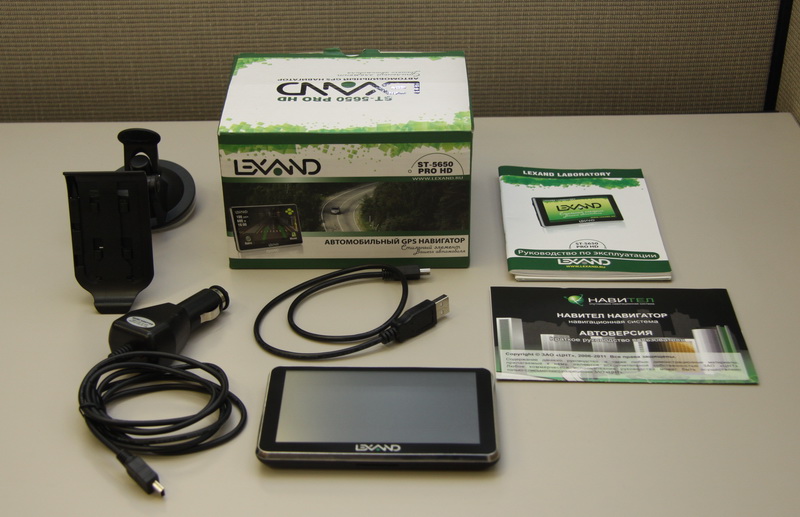
The set is standard for most navigators:
- actually navigator
- car cigarette lighter charging
- car holder on the glass,
- USB cable (simultaneously charges the device when connected to a computer),
- soft carrying case
- detailed instruction in Russian,
- Navitel license card (there are also options for CITY and CITEGID).
The device itself is strict and stylish. I like the body more than many other navigators: thin and no frills.
I just do not have enough wheel volume control, because often you have to mute the sound of clues if children sleep in the car. And this can be done only by going to the shell of the navigator, while closing the navigation program. On the other hand, there is an FM transmitter, and you can adjust the volume on the car stereo. But the sound, unfortunately, turns out to be too low, and you have to unscrew the volume, while increasing the parasitic noise.
Below are photos from all angles (I apologize for the quality - I can’t learn how to normally take close-up shots).
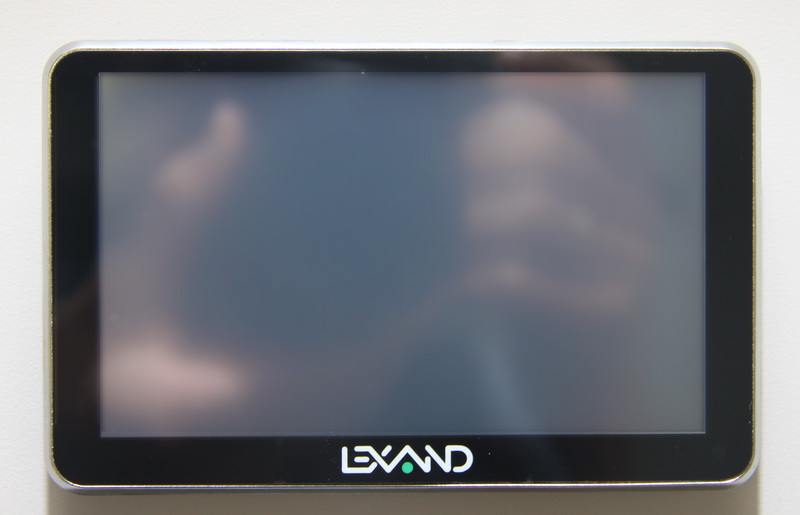





Comments are not particularly required - all connectors are signed and standard for most similar devices.
Let's move on to the practical part.
Turning on
The navigator does not turn on very quickly - about 15 seconds. But he knows how to fall asleep, and in this case, wakes up almost instantly.
Screen
The screen in the corners, traditionally for inexpensive navigators, is not very responsive. This does not interfere with the work of navigation programs, where most of the controls are large and designed to work with your finger. But in case of launching, say, regular IE, I sometimes can’t even close the window, because the close button is extremely small, located in the corner itself and not pressed, even with the stylus. Resolution 800x480 has now become the second most common standard for navigators. He suffices with his head and in long journeys, and in the city. Although, of course, sometimes you want to take a closer look at a large fragment of the map. The screen brightness is acceptable to me. But, of course, in the direct midday sun you can see badly. There is practically no glare, it is not enough brightness. Viewing angles are traditional for TN, so it's better to look at the screen at right angles. The mount, by the way, allows you to rotate the device in the horizontal plane with little or no effort - this is convenient if you want to show the card to the passenger.
Mount
I always liked the mounting on the glass from Lexand, there are no complaints here: 2 degrees of freedom - turning in a horizontal plane in a wide range and tilting the screen up and down. The sucker is reliable and is attached / removed very easily. The navigator itself is inserted into the mount with two latches and is held very tightly. At the same time, it can also be removed easily by tilting the upper presser lever.

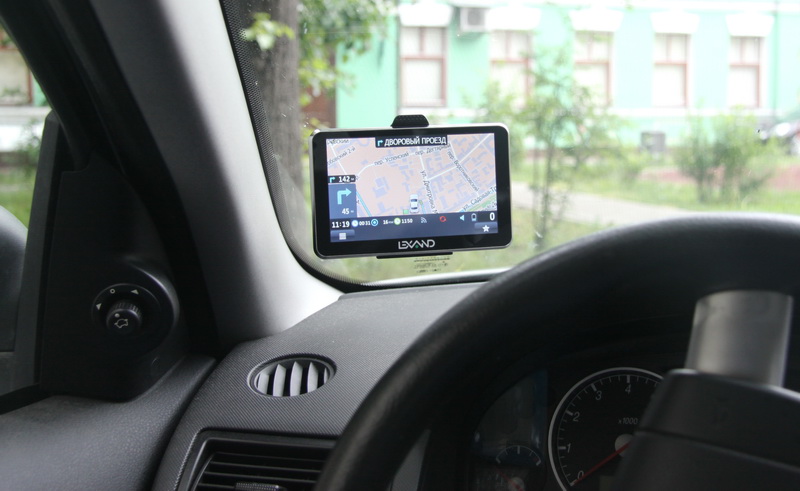
Charging
Charging wire meter and a half. Fans of hiding wires under a torpedo might find this length small, but I had no problems. Of the accessories, it would be nice to have another charge from the outlet - sometimes you want to build a device at home, without connecting to a computer or recharging when using, say, during a hike. A 1000 mAh battery lasts an hour and a half to two at maximum brightness and, probably, at 3-4 at minimum. By the way, speaking, this is quite enough to go on a multi-day hike and check there with maps in some Ozi Explorer, without fear of landing the battery.
Shell
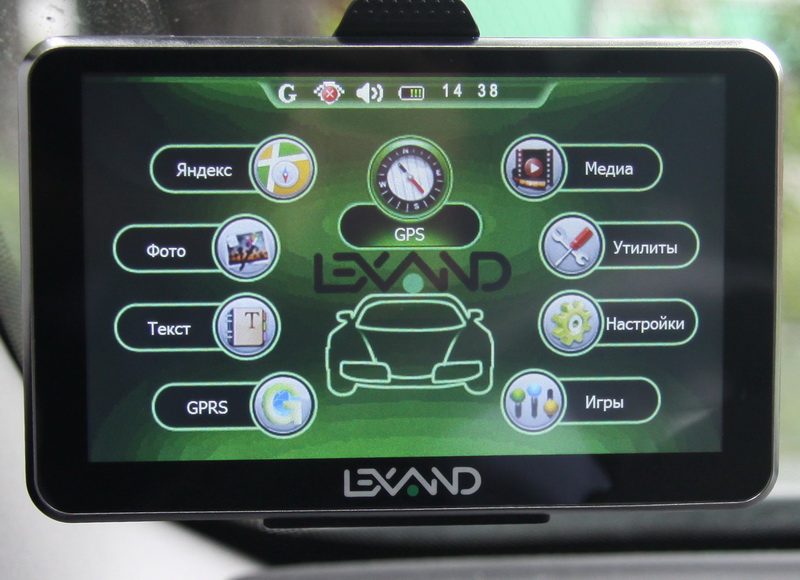
The shell looks beautiful, but a bit illogical. To start the navigation there are 2 buttons - the central one and the left - the smaller one. At the same time, I could not assign them names, although, as can be seen in the screenshot, one of the buttons was renamed to Yandex.Maps by someone. In my opinion, in the previous version it was, albeit not so beautiful, but more functional. Firstly, it was possible to select 3 navigation programs, and, secondly, to assign them any labels and names. In general, we still need to work on the interface.
Navigation
I checked in the latest versions of 3 programs: Navitel Navigator, Progorod and iGo Primo (it does not apply separately, I had to borrow a copy from numerous forums). I think it makes no sense to paint the interface and convenience of navigation programs here. Suffice it to say that they all worked stably and predictably.

The town is very pleased with the fact that it is rapidly developing and improving. From the last test a year ago, he became more stable and faster. With cards, too, not bad, although a couple of times he did try to lead me along a very strange route. But here still affects the youth of the system and the lack of resources for regular map updates. I didn’t like the fact that I couldn’t build a route from Moscow to the Crimea using maps from different manufacturers (the Ukrainian map was OSM). You need to make a route to the edge of one map, and then switch to another. The developers explain this by significant differences in the formats of the maps, but they seem to be going to implement them.
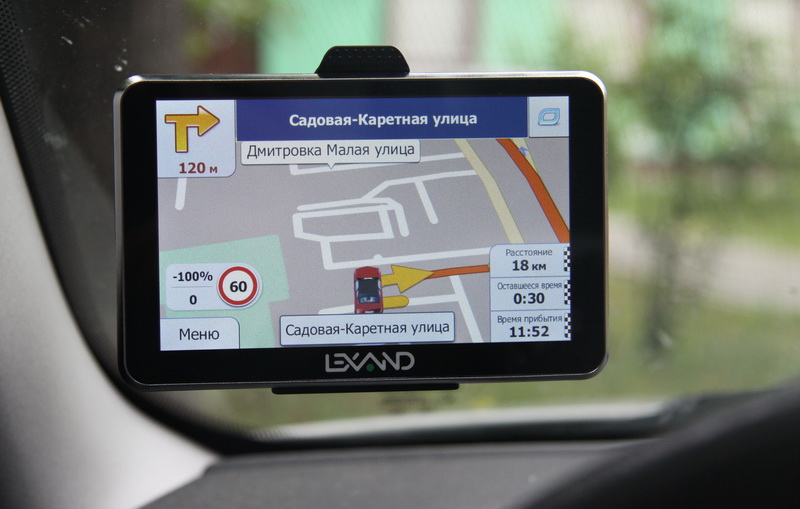
iGo, even in the weighted Primo version, is fast enough. Yes, there is no support for traffic jams here, but as a navigator for long journeys, including in the CIS, the program is ideal. I have never come across such an elaboration of the interface to the last detail. Developers "Progorod" - study, please, in detail iGo and take from there all the best.
With Navitel, I somehow do not add up. There is, of course, a lot of subjective things — I don’t like the interface and can't do anything about it. Inaccurately drawn map, and the route on it looks cumbersome. Probably, this is all ruled by skins, but I never tried. In addition, the rendering speed is worse than the other two tested programs. Since the opinion is subjective here, I will not paint anything more.
GPRS, traffic jams
The functionality of GSM / GPRS developers Lexand can not manage to bring to mind. Those. Of course, it works, but there are two BUT. Firstly, very slowly and at times unstable. It is clear that this is not 3G, but for GPRS it is already a bend. When the traffic jams display was turned on, the Progorod one time hung. And I think the problem here is hardware. And, secondly, the interface is just awful. I think that it was not necessary to make a fuss with calls, SMS and a browser. Let there be only the possibility of requesting traffic jams on GPRS. The quality of the interface development can be illustrated with just one screenshot without words:

I did not understand what they wanted to say here ...
The built-in IE browser is so miserable that it’s not worth talking about it seriously. True, the device has a mode of working with pure Windows CE, without a shell. There you can run any program, including alternative browsers. And, probably, you can somehow customize the standard shell and replace the embedded calls with third-party programs. But in any case, this is not a task for ordinary users. And the “out of the box” GPRS functionality, I repeat, is inconvenient and ill-conceived.
Multimedia
As for multimedia capabilities, everything is also standard here: photos, music, text, video. I did not investigate all this in very detail, but, as a first approximation, everything works. The child regularly watched cartoons on vacation. But even in 640x480 resolution, the regular player sometimes skips frames. Probably, if you put TCPMP, it will be faster. But this should not be a very important issue for the device, the main purpose of which is high-quality navigation work. And there are almost no complaints: the GPS receiver is fast and accurate. Usually at the time of launch of the navigation program, he has already determined the coordinates. Little is lost among the high houses in the courtyards, but this is a common GPS problem.
findings
In general, I am satisfied with the navigator. It performs the main function perfectly well. The price of 4.5-5 thousand rubles for a device with such functions is acceptable, although, of course, the Chinese offer cheaper. And, given that Lexand is also doing in China, one could, of course, reduce the price a bit. But here, nevertheless, there is a Russification of the menu, a Russian guarantee and support, which is important for many.
Pros of the tested navigator:
+ Good and fast catches satellites
+ Allows you to run any program
+ Works stably
+ Not overloaded with anything
+ Nice appearance, slim and stylish body
+ Reliable and convenient fastening
+ Long enough autonomous work
+ High resolution screen
+ Support for loading traffic jams
Minuses:
- Confused GPRS setting
- Regular IE browser
- Plays on video 640x480 and higher
- No volume control wheel.
Source: https://habr.com/ru/post/146924/
All Articles